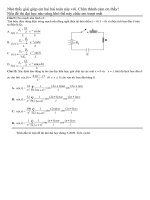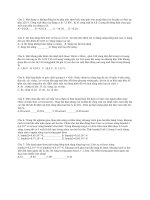nho cac bac dich giup em bai nay sang tieng viet
Bạn đang xem bản rút gọn của tài liệu. Xem và tải ngay bản đầy đủ của tài liệu tại đây (483.03 KB, 37 trang )
Data Link Layer Fundamentals
© 2004 - iPMAC Informatics Technology J.S.C
Cisco Icons and Symbols
IPMAC
Networking Academy
Overview
Different Layer 2 features
Ethernet and the LAN standards today.
Operation of hubs and switchs.
Ethernet family and its Future
IPMAC
Networking Academy
Typical LAN Features for OSI Layer 1
The physical layer defines the standards used to send and
receive bits across a physical network.
The physical layer defines the details of cabling:
The maximum length allowed for each type of cable.
The number of wires inside the cable.
The shape of the connector on the end of the cable…
Most cable include several conductors (wires) inside the
cable.
The endpoint of these wires are called pins, which end
inside the connector.
The physical layer also must define the purpose of each
pin.
IPMAC
Networking Academy
CAT5 Cable with RJ-45 Connector
RJ-45 is a typical connector used with Ethernet cabling today.
One pair of wires is used for transmitting data, using pins 1 and
2.
One pair of wires is used for receiving data, using pins 3 and
pins 6.
IPMAC
Networking Academy
Typical LAN Features for OSI Layer 2
The data link layer defines the standards and protocols used to
control the transmission of data across a physical network.
Each data link protocol “controls” a particular type of physical
layer network, the details of how a data link protocol functions
must include some consideration of the physical network.
Most of data link protocols perform the following functions:
Arbitration
Addressing
Error detection
Identification of the encapsulated data
IPMAC
Networking Academy
Data Link Function 1: Arbitration
With some type of physical networks, data frames can
collide if devices can send any time they want.
When frames collide in a LAN, the data in each frame is
corrupted and the LAN is unusable for a brief moment.
The specifications for these data-link protocols define how
to arbitrate the use of the physical medium to avoid
collisions, ar at least to recover from the colisions when
they occur.
Ethernet uses the carrier sense multiple access with
collision detection (CSMA/CD) algorithm for arbitration.
IPMAC
Networking Academy
Data Link Function 2: Addressing
Many physical networks allow more than two devices
attached to the same physical network.
Data-link protocols define addresses to make sure that the
correct device listens and receives the data that is sent.
By putting the correct address in the data-link header, the
sender of the frame can be relatively sure that the correct
receiver will get the data.
Each data-link protocol defines its own unique addressing
structure
Ethernet uses Media Access Control (MAC).
Frame Relay uses data-link connection identifier (DLCI).
IPMAC
Networking Academy
Data Link Function 3: Error Detection
Error detection discovers whether bit errors occurred
during the transmission of the frame.
Most data-link protocols include a frame check sequence
(FCS) or cyclical redundancy check (CRC) field in the datalink trailer.
This field contains a value that is the result of a
mathematical formula applied to the data in the frame.
If the FCS sent by the sender matches the FCS calculated
by the receiver, the frame did not have any errors.
Error detection does not imply recovery.
The FCS allows the receiving device to notice that errors
accurred and then discard the data frame.
IPMAC
Networking Academy
Data Link Function 4: Identifying the Encapsulated Data
This function identifies the contents of the Data field in
the frame.
Each data-link header has a Type field to identify the type
of protocol that sits inside the frame’s data field.
IEEE Ethernet 802.2 Logical Link Control (LLC) uses a field
in its header to identify the type of data in the Data field.
Coming up … Ethernet Standard
IPMAC
Networking Academy
Early Ethernet Standards
In this section, you learn about the three earliest
types of Ethernet networks.
The term Ethernet refers to a family of protocols and
standards that together define the physical and data
link layers of LAN.
There are many variations of Ethernet
More popular: 10BASET, Fast Ethernet, Giganet
Older types: 10BASE2, 10BASE5
IPMAC
Networking Academy
Ethernet Standards Overview
Xerox needed an effective way to allow a new invention, called
the personal computer, to be connected in its offices.
Xerox teamed with Intel and Digital Equipment Corp. (DEC) to
further develop Ethernet.
The original Ethernet became known as DIX Ethernet, meaning
DEC, Intel, and Xerox.
The IEEE created a standardized version of Ethernet base on
the work performed by DEC, Intel, and Xerox.
IPMAC
Networking Academy
Introduction to Ethernet
Most of the traffic on the Internet originates and
ends with Ethernet connections.
The success of Ethernet is due to the following
factors:
Simplicity and ease of maintenance
Ability to incorporate new technologies
Reliability
Low cost of installation and upgrade
Bandwidth can be increased without changing underlying
technology
IPMAC
Networking Academy
Ethernet and the OSI model
Divided OSI Layer 2 into two sublayers
Media Access Control (MAC) – Traditional L2 features
Transitions down to media
Logical link control (LLC) – New L2 features
Transitions up to the network layer
IPMAC
Networking Academy
LLC sublayer
Packet
Packet
LLC PDU
Packet
Frame
LLC PDU includes:
DSAP: Destination service access point
SSAP: Source service access point
Supports connection control methods specified by upper protocols
IPMAC
Networking Academy
Original Ethernet Standard: 10BASE5
The original 1980 Ethernet product 10BASE5 transmitted 10
Mbps over a single thick coaxial cable bus.
10BASE5 was the first medium used for Ethernet.
The primary benefit of 10BASE5 was length.
10BASE5 systems also represent a single point of failure.
Each of the maximum five segments of thick coax may be up to
500 m (1640.4 ft) in length.
Because the medium is a single coaxial cable, only one station
can transmit at a time or else a collision will occur.
10BASE5 only runs in half-duplex resulting in a maximum of 10
Mbps of data transfer.
IPMAC
Networking Academy
Original Ethernet Standard: 10BASE2
10BASE2 was introduced in 1985.
Installation was easier because of its smaller size, lighter
weight, and greater flexibility.
Computers on the LAN were linked together by an unbroken
series of coaxial cable lengths.
Each of the maximum five segments of thin coax may be up to
185 meters long and each station is connected directly to the
BNC “T” connector on the coax.
Only one station can transmit at a time or else a collision will
occur.
10BASE2 also uses half-duplex.
The maximum transmission rate of 10BASE2 is 10 Mbps.
Coming up … CSMA/CD
IPMAC
Networking Academy
What is CSMA/CD?
If two or more signals were sent at the same time, the two
would overlap and collide
Ethernet defined a specification for how to ensure that only one
device sends traffic on the Ethernet at one time.
The algorithm is carrier sense multiple access with collision
detection (CSMA/CD).
CSMA/CD logic helps prevent collisions an also defines how to
act when a
collision does occur.
IPMAC
Networking Academy
How CSMA/CD works?
1.
2.
3.
4.
5.
6.
A device with a frame to send listens
until the Ethernet is not busy.
When the Ethernet is not busy, the
sender begins sending the frame.
The sender listens to make sure that
no collision occurred.
Once the sender hear the collision,
they each send a jamming signal, to
ensure that all stations recognize the
collision
After the jamming is complete, each
sender randomizes a timer and waits
that long (backoff algorithm).
When each timer expires, the process
stars over with step 1.
IPMAC
Networking Academy
Repeaters
10BASE5 and 10BASE2 had limitations on the total length of
cable.
The signal sent by one device could attenuate too much if the
cable was longer than 500m or 185m.
Repeaters take an incoming signal, regenerate it and pass it on.
IPMAC
Networking Academy
10BASE-T Ethernet
10BASE-T solved several problems with the early Ethernet
specifications
10BASE-T allowed the use of telephone cabling that was
already installed, or simply allowed the use of cheaper, easierto-install cabling when new cabling was required.
10BASE-T networks make use of devices called hubs.
IPMAC
Networking Academy
Hubs
The hubs are multiport repeaters.
The hub simply regenerates the electrical signal that come in
one port and sends the same signal out every other port.
By doing so, 10BASE-T creates an electrical bus, just like
10BASE5 and 10BASE2.
Collisions can still occur, so CSMA/CD access rules
continue to be used.
With 10BASE-T, a cable is run from each device to a hub, so
a single cable problem affects only one device.
All devices are sharing a single bus, so we call this shared
Ethernet.
IPMAC
Networking Academy
10BASE-T Hub operation
1. NIC sends a frame.
2. NIC loops the frame back.
3. Hub receives the frame.
4. Hub sends it to all ports,
except the received port.
5. Hub sends the frame out.
If two PCs sent a frame
at the same time, a
collision would occur.
IPMAC
Networking Academy
Collisions and Duplex Settings
10BASE2, 10BASE5, and 10BASE-T Ethernet would
not work without CSMA/CD.
With CSMA/CD algorithm, Ethernet becomes more
inefficient under higher loads.
In the next section, you will read about two things
that have improved network performance, both
relating to the reduction or even elimination of
collisions:
LAN Switching
Full-Duplex Ethernet.
IPMAC
Networking Academy
Reducing Collisions - LAN Switching
LAN switches overcome the
problems created by collisions and
the CSMA/CD algorithm by removing
the possibility of a collision.
Switches do not create a single
shared bus, they treat each
individual port as a separate bus.
Switches use memory buffers to hold
incoming frame.
Switch performs OSI Layer 2
functions by interpreting Ethernet
header information to make
forwarding decisions.
IPMAC
Networking Academy









